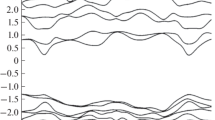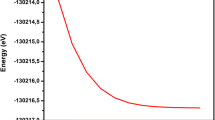Abstract
We have performed spin-polarized density functional theory calculations on κ-carbides, (Fe, Mn)3AlC, to investigate both the effect of different exchange-correlation functionals and the effect of Mn substitution. Differently from our previous calculations using the Perdew-Wang functional, Fe2MnAlC is found to be the most stable crystal among crystalline κ-carbides by using the Perdew, Burke, and Ernzerhof functional. Supercell calculations to simulate low Mn concentration show that substitutional Mn atoms hardly interact with each other and suggest that a random alloy model can be applied. The stabilization of Fe2MnAlC and its enhanced magnetization are attributed to the formation of a -Mn-C- linear chain structure.
Similar content being viewed by others
References
W. S. Yang and C. M. Wan, J. Mater. Sci. 24, 3497 (1989).
G. Frommeyer and U. Brüx, Steel Res. Int. 77, 627 (2006).
O. Acselrad, A. R. Souza, I. S. Kalashnikov and S. S. Camargo, Wear 257, 999 (2004).
Y. Kimura, K. Handa, K. Hayashi and Y. Mishima, Intermetallics 12, 607 (2004).
Y. Sutou, N. Kamiya, R. Umono, I. Ohnuma and K. Ishida, ISIJ Int. 50, 893 (2010).
J. W. Lee and T. F. Liu, Mater. Chem. Phys. 69, 192 (2001).
D. Connétable and P. Magis, Intermetallics 16, 345 (2008).
A. Kellou, T. Grosdidier, J. M. Raulot and H. Aourag, Phys. Status Solidi B 245, 750 (2008).
Ma. Palm and G. Inden, Intermetallics 3, 443 (1995).
H. Hosada, S. Miyazaki and Y. Mishima, J. Phase Equilib. 22, 394 (2001).
J.-Y. Noh and H. Kim, J. Korean Phys. Soc. 58, 285 (2011).
J. P. Perdew, J. A. Chevary, S. H. Vosko, K. A. Jackson, M. R. Pederson, D. J. Singh and C. Fiolhais, Phys. Rev. B 46, 6671 (1992).
J. P. Perdew, K. Burke and M. Ernzerhof, Phys. Rev. Lett. 7, 3865 (1996).
P. Hohenberg and W. Kohn, Phys. Rev. 136, B864 (1964).
W. Kohn and L. J. Sham, Phys. Rev. 140, B1133 (1965).
G. Kresse and J. Hafner, Phys. Rev. B 47, 558 (1993).
G. Kresse and J. Hafner, Phys. Rev. B 49, 14251 (1994).
G. Kresse and J. Futhmüller, Phys. Rev. B 54, 11169 (1996).
G. Kresse and J. Futhmüller, Comput. Mater. Sci. 6, 15 (1996).
P. E. Blöchl, Phys. Rev. B 50, 17953 (1994).
G. Kresse and D. Joubert, Phys. Rev. B 59, 1758 (1999).
P. E. Blöchl, O. Jepsen and O. K. Andersen, Phys. Rev. B 49, 16223 (1994).
H. J. Monkhorst and J. D. Pack, Phys. Rev. B 13, 5188 (1976).
Y. Wen, C. Wang, Y. Sun, Gu. Liu, M. Nie and L. Chu, J. Alloy. Compd. 489, 289 (2010).
E. Clementi, D. L. Raimondi and W. P. Reinhardt, J. Chem. Phys. 38, 2686 (1963).
D. Hobbs, J. Hafner and D. Spišák, Phys. Rev. B 68, 014407 (2003).
In fact, the large formation energy of Fe3AlC in the PW91 calculations seems to originate from the reduced stability of FM bcc Fe because the chemical potential of Fe is about 0.2 eV/atom higher for PW91 than the case of PBE, which is at least twice larger than the differences in other elements (0.09, 0.04, and 0.01 eV/atom for Mn, Al, and C, respectively).
N. I. Medvedeva, R. A. Howell, D. C. Van Aken and J. E. Medvedeva, Phys. Rev. B 81, 012105 (2010).
Author information
Authors and Affiliations
Corresponding author
Rights and permissions
About this article
Cite this article
Noh, JY., Kim, H. Ab initio calculations on the effect of Mn substitution in the κ-carbide Fe3AlC. Journal of the Korean Physical Society 62, 481–485 (2013). https://doi.org/10.3938/jkps.62.481
Received:
Published:
Issue Date:
DOI: https://doi.org/10.3938/jkps.62.481




